#paravian
Text


#Archovember Day 1 - Your Choice!
In my ongoing effort to draw all the non-avian dinosaurs we know the colors of, I’ve chosen Anchiornis huxleyi!
The type species for the Anchiornithids (“near birds”), Anchiornis huxleyi was a crow-sized dinosaur living in the Late Jurassic of Liaoning, China. It was relatively common, as hundreds of specimens have been uncovered in this area. But what makes Anchiornis so unique and important is that it was the first Mesozoic dinosaur species to have its entire life appearance be known by man! Having hundreds of well-preserved fossils available allows us to extract a lot of information about not only its size and shape, but its skin, feathers, and even coloration. Anchiornis had long wing feathers on its arms and legs (though its leg feathers were not as long as those of Microraptorians), fluffy downy feathers all over its body, a feathered crest on its head, and feathers covering its feet.
Only two Anchiornis fossils have had their well-preserved melanosomes studied so far. By comparing the structure of these melanosomes to modern birds, paleontologists have been able to infer the life colors of Anchiornis! It had mostly gray and black body feathers and white forewing and hindwing feathers with black tips. Its tail colors remain unknown. The first specimen of Anchiornis to be surveyed for melanosomes also had red or rufous coloring on its crest, as well as rufous speckles on its otherwise black and gray head. However, the second specimen did not have any rufous coloration. This may be due to different preservation of melanosomes, different investigative techniques, the animals in question having regional differences or even being different species/subspecies, the second Anchiornis being younger, or sexual dimorphism.
While Anchiornis had rather large feathered forelimbs, it didn’t seem to have been much of a flier. Unlike the later Microraptorians, its wings were rounded and relatively short compared to other flying dinosaurs, and the flimsy flight feathers overlapped each other to strengthen them. A 2016 study concluded that while juvenile Anchiornis may have been able to use their wings to assist with leaping through the trees, adults were simply too heavy and their wings too small to gain any lift. Instead, it is more likely their wings were used for display. As their legs were long, they may have been adapted for speed, using their wings to aid in aerodynamics as they quickly darted through the underbrush.
Pellets (such as those coughed up by owls) have been found both within and in association with Anchiornis, and contained lizard bones and fish scales. Prey items that could have also been eaten by Anchiornis include insects, arachnids, salamanders, small anurognathids (such as Cascocauda, who we will be visiting later this month) and other small or juvenile pterosaurs, and small cynodonts like Agilodocodon and Juramaia.
Anchiornis lived alongside other Anchiornithids such as Aurornis, Caihong, Eosinopteryx, Pedopenna, Serikornis, Xiaotingia, as well as the Scansoriopterygids Yi, Scansoriopteryx, and Epidexipteryx. It also lived alongside the quilled heterodontosaurid Tianyulong.
#my art#SaritaDrawsPalaeo#Anchiornis huxleyi#Anchiornis#Anchiornithid#paravian#theropods#saurischians#dinosaurs#archosaurs#archosauromorphs#Archovember#Archovember2023
27 notes
·
View notes
Text

Urvogel
(First art of 2024 yippee)
#art#illustration#my art#digital art#paleoart#paleontology#palaeoblr#birblr#archosaurs#dinosaurs#theropods#coleurosaurs#maniraptorans#paravians#birds#archaeopteryx#tumblr radar
2K notes
·
View notes
Text
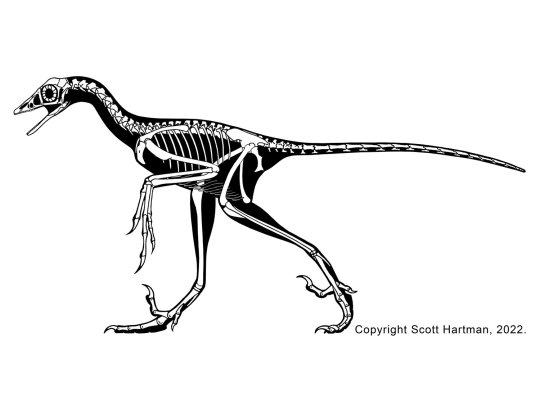

One of these is a dinosaur and one is a bird. As you can see, they are clearly soooo radically different from each other that there cannot possibly be any overlap between these two groups. Drawing a line between dinosaurs and birds is easy! You just have to, uh, ummm, uhhh....... quick, what's that! [disappears in a puff of smoke]
556 notes
·
View notes
Text
175 notes
·
View notes
Text
I WILL gatekeep insomnia if melatonin does anything to you you’re not insomniac you're just a little restless
4 notes
·
View notes
Text
Anchiornis

Anchiornis is a small paravian dinosaur from the Late Jurassic of China. It could grow to around 60 cm in body length with a wingspan nearly as wide, and weighed about 1 kg. In addition to the front wings, Anchiornis had long feathers on the hind legs, leading many scientists to call it a four-winged dinosaur. Thanks to an extremely well-preserved specimen, scientists have been able to study the melanosomes in the feathers and determine the full body colors and patterns of Anchiornis. The body was mainly black and gray and the primary feathers were white with black tips and patterns. It also sported a red crest on the top of its head.
118 notes
·
View notes
Text
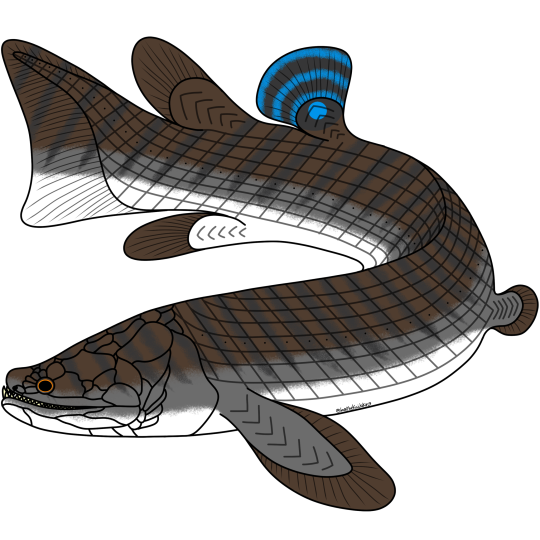
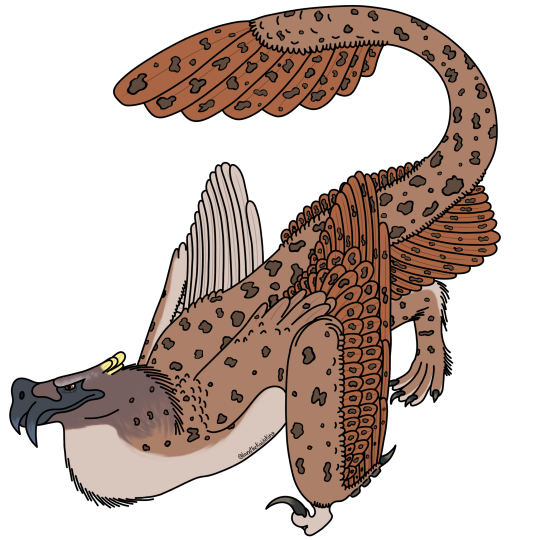
Art commissions for @glavenychus and @bogbiter
An amphibious mangrove dwelling Porolepiform for Glave’s permotriad
And a paravian descendant West Asian Griffin for Bog’s book series Awakened: Bleeding Realm
#art#commissions#speculative evolution#speculative ecology#speculative biology#griffin#glavenychus#bogbiter#awakened: bleeding realm#permotriad
29 notes
·
View notes
Text

Today's dinosaur is Rahonavis, a late Cretaceous Paravian, hypothesized to be capable of powered flight
51 notes
·
View notes
Text
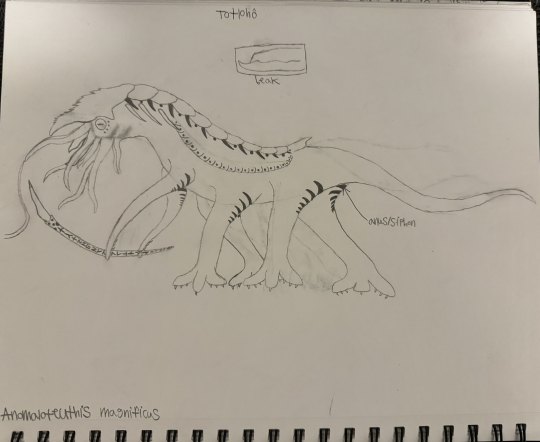
Totlohô
Kingdom: Animalia
Phylum: Mollusca
Class: Cephalopoda
Subclass: Nautiloidea
Superorder: Alysidaceratoidea
Order: Paratetrapoda
Superfamily: Cotylopodoidea
Family: Cotylopodidae
Subfamily: Anomaloteuthiinae
Genus: Anomaloteuthis
Species: A. magnificus (”magnificent unusual squid”)
Ancestral species: possibly Plectronoceras cambria
Temporal range: Early Jurassic (Toarcian) to Early Cretaceous (Hauterivian) (180 - 130 mya)
Information:
While humans have long seen themselves as the first and only sapient species to inhabit their planet, in all truth, there existed another in Xenogaea several hundreds of millions of years ago, one whose legacy can still be felt throughout the region untold eons later in their bizarre ruins and artifacts: the Totlohô-tu-Tẋusko/Tẋusko-tu-Totlohô (IPA: /to̞t͡ɬo̞hɔ tu t͡ʃusko̞/ OR /t͡ʃusko̞ tu to̞t͡ɬo̞hɔ/, meaning "ancestor of (the) architect"), better known as simply the Totlohô (/to̞t͡ɬo̞hɔ/, simply meaning "architect").
As soft tissues of this species have only rarely been preserved, and hard tissues consist only of armor plating and beaks, their size and general appearance alone must be inferred purely based on known proportions from living relatives, other members of the aberrant nautiloid clade Alysidaceratoidea, known more colloquially as the shrikehounds. The most reliable size estimate places them at around 12 feet long, 6-7 feet tall, and weighing close to 600 lbs. The appearance of these creatures, based on ancient stone murals, would seem to suggest that they were centaur-like in build, sporting six main limbs along with a menagerie of smaller tentacles around the face, which housed a long, narrow beak with a noticeable underbite. The exact coloration of this species isn’t known, though as murals exist which depict them, it can be inferred that they might have had a similar coloration pattern to living nautili, with a creamy-colored body and eyes with an earthy red shell and head piece.
Living shrikehound species are not particularly vocal, with only the paratetrapods having an analogue to proper vocal cords. This species was presumably vocal in some capacity, though the exact vocalizations cannot be deduced. It has been suggested that like their living relatives, they might have been able to produce clicks, grunts, warbles, rumbles, belches, screeches, and shrieks. It has been suggested, however, that they may have convergently evolved chromatophores like some of their living relatives and may have had a primarily visual language instead, one which has not, as of yet, been decoded.
Much of these organism's general biology is not known conclusively. Most evidence points to a carnivorous diet, consisting mainly of small dinosaurs/paravians, but also other terrestrial nautiloids, small mammals, and a bizarre group of terrestrial acanthodians known as coelospondyls. Though the exact place where they first evolved has yet to be conclusively found, fossilized beaks first appear in the Matansitra Formation in the southwest of the Isle of Perils, though later formations across the entire archipelago show that almost every habitable landmass sported a population of these creatures at one point. Dubious material from areas outside the archipelago, including what is now China and Australia, suggests they may have eventually left the archipelago at some point as well. At their peak during the Kimmeridgian age of the Late Jurassic epoch roughly 150 millions years ago, their population size was likely upwards of 40 million. Very little (if anything) can be inferred about their reproductive biology, though murals would seem to suggest that courtship and copulation was a very long, drawn-out process, treated almost as an art form unto itself. From their closest relatives, it can be inferred that the males, using a modified tentacle, deposited sperm into a small groove on the female’s underside, where it could be absorbed and used to fertilize the eggs. Their clutch size is believed to have been anomalously small compared to other species in their clade, possibly no more than 10 eggs at a time. The young appear to have matured at a similar rate to human young, if not slightly faster. Sexual dimorphism does not appear to be a prominent trait within their species.
Not much can be inferred about the behavior of this species from what remnants have been found, though it can be inferred that they were likely highly social creatures with complex social structures. They appear to have engaged in agrarianism and the farming of other animals in their later stages of societal development, as evidenced by a high correlation in dump beak remains found near dump sites for animal bones and shell, and even built cities. Murals would seem to suggest Totlohô society was ruled by a class of elders, the oldest respective members of their society, while the youngest members formed the work force. Song and dance appear to have been ways to bond with one another, and spirituality played a large part in their society’s function. Warfare appears to have been an isolated phenomenon in their society and frequently on a much smaller scale than as seen in humanity, though there exists some evidence of widespread warfare in the later years of existence. Even in their later stages, when they evidently had significantly advanced technology (or, as the more conspiracy-minded would suggest, magic of some kind), the Totlohô still preferred to build their homes out of stone.
During the later stages of their existence, the Totlohô appear to have dabbled in what appears to be highly-advanced technology or potentially even magic of some kind, as evidenced by massive, seemingly Totlhômade, carved, levitating stones covered in glyphs. In a place known as the Square Chasm (picture below, artwork by Dipfruit), a reportedly supernatural space some weary jungle travelers have stumbled upon near a triple-forked river, one of these stones appears to have formed a perfectly square-shaped pocket dimension around itself, where gravity itself appears to bend to the stone’s whim.

Fossilized beaks and hard shells are really the only physical parts of these creatures to have been preserved, and they are the only indication of their existence outside of aforementioned ruins and murals. Their written languages have yet to be decoded, and there are believed to have been several thousand at a given time. What exactly led to their extinction has yet to be conclusively revealed, though murals seem to suggest that, from their perspective, supernatural forces may have been at play, with recurrent imagery of what appears to be demonic figures showing up across several murals. Another recurrent image in these murals is a white bird-like creature with horns, which some have suggested may be related to the mythical white bird seen in Xenogaean mythology, which was said to herald the apocalypse. While some have suggested that these murals may have been painted by one of the last Totlohô, who had simply gone insane from isolation and began painting their hallucinations, others suggest that there might be a grain of truth in these murals, perhaps a war of apocalyptic scale which engulfed the entire species, the demagogues fueling it being portrayed as demonic figures. What this doesn’t explain, however, are the high number of artifacts which appear to be made from an unknown metallic substance, one which is highly durable and in near-pristine condition hundreds of millions of years later. This substance, referred to colloquially as “anomalous tungsten”, is paradoxically lightweight yet durable with a high melting point, seemingly higher than almost any other known metal or metalloid. As this metal has not been found anywhere on Earth or even in any known compounds on Earth or another planet, this begs the question of how and where the Totlohô obtained this substance, leading to a wide menagerie of conspiracy theories, with everything from extraterrestrials to divine beings being suggested as the source from which they obtained this material. Whatever the case, those who have studied the artifacts have claimed to have had vivid dreams where they spoke to the Totlohô shortly after contact. Perhaps this is just a form of confabulation or merely even group hysteria, but nonetheless, it would appear that even long after the Totlohô have left this world, their legacy still manages to touch the human spirit.
Finally, they appear to have domesticated a species of coelospondyl, Platycephale aridus, the so-called “flat-faced coelospondyl” (1st picture below, artwork by me), and another species of shrikehound, which is currently unnamed (2nd picture below, artwork by me). These appear to have been utilized as livestock animals.


#novella#speculative evolution#fantasy#scifi#scififantasy#speculative biology#speculative fiction#speculative zoology#worldbuilding#creature art#sophont#sci fi creature#creature design#fantasy creature#creative writing#creature#scifi worldbuilding#fantasy worldbuilding#nautiloid#nautilus#cephalopod#mollusk#cephalopods
18 notes
·
View notes
Text

New Paravian flying wyvern ancestor design
its been quite a while since i've done some monster hunter stuff so i wanted to do something related to it and i decided to revist my parave wyvern design i made like almost 7 months ago and i really didnt like how it looked so i decided to redesign it!
it is based of @iamthekaijuking's theory on every flying/bird wyverns being descendant from a small paravian dinosaur that evolved more flexible hands to climb and burrow aswell as growing pseudo fingers for wings!
mine has 2 more pseudofingers on each hands one for the wing and one for an opposable thumb as i thought it would look neat aswell as making my creature being able to climb and dig better aswell as interacting with the environment as it was my idea i had when i first made this little fella!
14 notes
·
View notes
Text
It Came From The Wastebasket #12: Coelurosaur Confusion
Historically Coelurosauria was the counterpart to the Carnosauria, with both of them representing two major lineages of theropod dinosaurs.
Created as a group in the early 20th century, coelurosaurs quickly became a dumping ground for all small-bodied theropods – including coelophysoids, compsognathids, ornithomimids, oviraptorosaurs, dromaeosaurids, and troodontids– and for a while this wastebasket taxon also included the large-bodied ceratosaurids and tyrannosauroids, before they were moved over into the carnosaurs.
But during the 1960s and 1970s this arrangement began to break down. A better understanding of groups like dromaeosaurs revealed a confusing mixture of traditional "carnosaur" and "coelurosaur" anatomical features, and paleontologists struggled to figure out where these sorts of theropods actually fit in.
The development of cladistic methods from the 1970s onwards led to efforts to clean up the coelurosaur wastebasket, trying to figure out a more accurate version of these animals' evolutionary relationships. After briefly collapsing Coelurosauria down to just coelophysoids and "coelurids", the growing recognition of modern birds as living theropod dinosaurs eventually resulted in the group being properly redefined in the 1980s as "birds, and all theropods closer related to them than to carnosaurs".

Clockwise from the left (not to scale): Citipati osmolskae, Albertosaurus sarcophagus, Yi qi, Sinosauropteryx prima
The coelophysoids were finally removed entirely, reclassified as a much earlier branch of theropods – but quite a few of the other groups from earlier concepts of Coelurosauria survived this reshuffling, with the compsognathids, ornithomimids, oviraptorosaurs, dromaeosaurs, and troodontids all proving themselves to have really been closely related the whole time. Meanwhile the tyrannosauroids were brought back in, along with the therizinosaurs, alvarezsauroids, and a whole bunch of paravian and avialan lineages.
(Megaraptorans might belong somewhere in the coelurosaurs, too – possibly being tyrannosauroids – but their classification is currently being disputed.)
———
Nix Illustration | Tumblr | Twitter | Patreon
#it came from the wastebasket#wastebasket taxon#taxonomy#coelurosauria#theropod#dinosaur#paleontology#art#science illustration#paleoart#palaeoblr
231 notes
·
View notes
Text

Luzon bleeding-heart dove watercolour in a different style from my usual one
#art#my art#traditional art#watercolour#wildlife art#birblr#archosaurs#dinosaurs#theropods#coleurosaurs#maniraptorans#paravians#avialans#birds#columbiformes#pigeons#gallicolumba#gallicolumba luzonica#luzon bleeding-heart dove#queue
94 notes
·
View notes
Text
Now myself, I like to consider paravians as the starting point for birds because (1) going crown group only is just silly [gestures to enants] but (2) there really just isn’t any meaningful distinction between early avialans and dromaeosaurs, and (3) if we go with powered flight, it probably happened a bunch of times in paraves anyway…
But that’s just me being the resident paravian propaganda artist. :P Go and call all of ornithodira birds, it’s fine.
#god imagine if we had living pterosaurs#they’d be the avian equivalent of the platypus#bird political spectrum#paravian propaganda
18 notes
·
View notes
Text
Fossil Novembirb 8: The Raptors Are Back
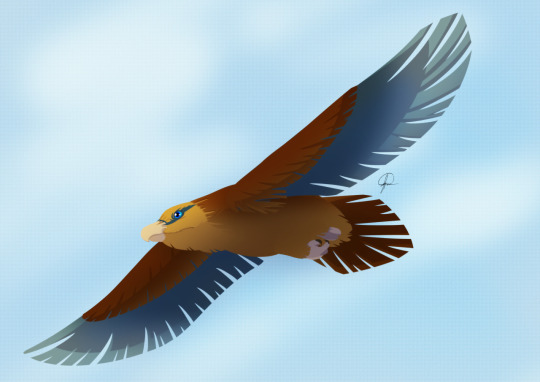
Palaeohierax by @quetzalpali-art!
Alright we're back with a look at the raptors of the Paleogene!
Raptor meaning, of course, bird of prey. Which I wouldn't have to say, except this is a dinosaur blog, and a lot of the time people in dinosaur circles use "raptor" to mean "Dromaeosaur" exclusively. Ironic, given that birds of prey used the word first!

Pulchrapollia by @drawingwithdinosaurs
We've already talked about some of the birds of prey that appeared right after the extinction, such as all the early owls, Qianshanornis, and Danielsraptor. Truth is, being a carnivore is a useful ecology, and birds - having evolved from Paravians like Dromaeosaurs - already have a lot of the tools for chowing down! So, carnivorous birds just keep re-evolving all the time - corvids are sometimes considered raptors, and they're deeply nested within Passerines! And of course, modern roadrunners are essentially mini Velociraptors, but they're cuckoos!
In fact, it seems that most birds alive today evolved from a carnivorous ancestor! All the early-branching members of Telluraves, aka "Core Land Birds" (which includes all passerines and many more besides) are raptorial - owls, hawks, eagles, kites, seriemas, even falcons. And the early ancestors of Passerines and Parrots - things like Halcyornis - were birds of prey as well!
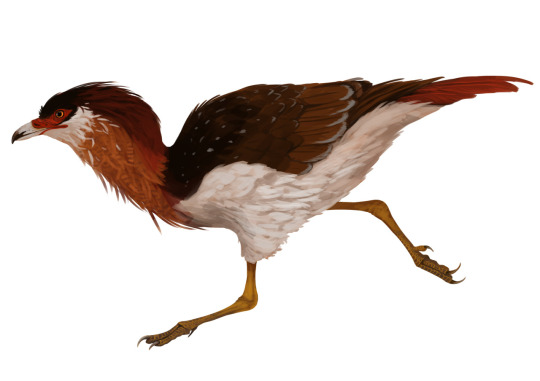
Dynamopterus by @thewoodparable
As we saw with Danielsraptor and Qianshanornis, fast running predatory birds have been a thing since the ash started clearing up from the asteroid. There are just so many small animals to eat and so little time to catch them! Relatives of falcons and seriemas continued to pursue (heh) this lifestyle, and were quite common in the Paleogene fossil record.
In fact, Seriemas - today limited to just a handful of species in South America - had a very successful time of it during the Paleogene and Neogene, with species spread all across the globe. Dynamopterus (sometimes called Idiornis) was from the later Eocene of Europe, and it lived very similarly to living seriemas in its ecosystem! Itaboravis was present in the early Eocene in South America, and we also have Bathornis in North America!
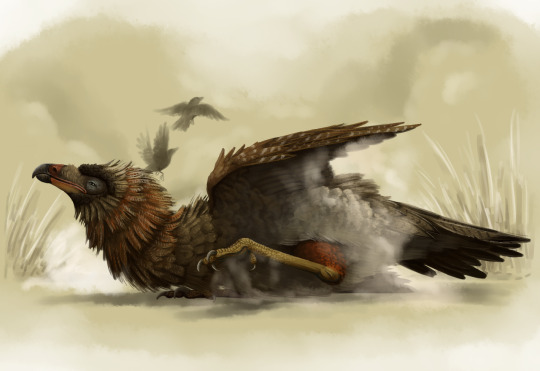
Bathornis by @drawingwithdinosaurs
Bathornis was a very terror-bird-like seriema relative that lived in North America from the Eocene through the Miocene, found in many different environments and at many sizes throughout its existence, including plains and wetlands. Flightless like its terror bird cousins, it had a strong beak to help in catching food and powerful legs for moving quickly across the landscape to catch it!

Ogygoptynx by Apokryltaros/Avancna
Of course, I cannot ignore flighted predatory birds entirely. Though modern ones don't have a lot of fossil relatives (they start appearing in the Oligocene with forms like Palaeohierax), it seems that volant raptors were simply found in other clades - many owls were diurnal, and the relatives of modern parrots and passerines were small carnivores as I mentioned above. With ridges over their eyes to help with glare, these animals could find prey over long distances and fly to them rapidly from their perches - something quite terrifying for the little mammals they ate!
From grasping talons to sickle claws to powerful beaks and eyes, these animals - though small - had major impacts on their environments. Some grew to be so large they would hunt humans - but that's a story for another article.
Sources:
Mayr, 2022. Paleogene Fossil Birds, 2nd Edition. Springer Cham.
Mayr, 2017. Avian Evolution: The Fossil Record of Birds and its Paleobiological Significance (TOPA Topics in Paleobiology). Wiley Blackwell.
88 notes
·
View notes
Text
Migmanychion laiyang Wang et al., 2023 (new genus and species)
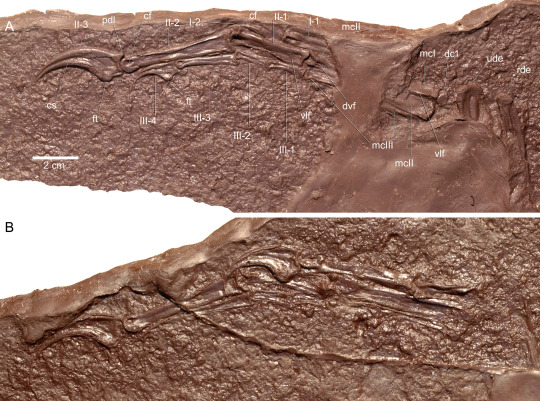
(Cast of the hand of Migmanychion laiyang, from Wang et al., 2023)
Meaning of name: Migmanychion = claw mixture [in Greek]; laiyang = Laiyang [referencing the Shandong Laiyang Cretaceous National Geological Park, where the original fossil is housed]
Age: Early Cretaceous (Aptian), about 121 million years ago
Where found: Longjiang Formation, Inner Mongolia, China
How much is known: A partial left forelimb (including a complete hand) and some rib fragments of one individual.
Notes: Migmanychion was probably a maniraptoran, a diverse group of feathered theropods including alvarezsaurs, therizinosaurs, oviraptorosaurs, and paravians (which in turn include birds). The bones in its hands were very slender and its hand claws were not sharply curved. A particularly unusual feature of its hands was that the claw of the second finger (equivalent to our index finger) was longer but not as deep as the thumb claw. In most other theropods, the longest hand claw is also the deepest.
Migmanychion might have been closely related to Fukuivenator, a maniraptoran from the Early Cretaceous of Japan that some recent studies suggest was an early therizinosaur. However, more complete specimens will likely be needed to confidently determine what type of maniraptoran Migmanychion was.
Reference: Wang, X., A. Cau, Z. Wang, K. Yu, W. Wu, Y. Wang, and Y. Liu. 2023. A new theropod dinosaur from the Lower Cretaceous Longjiang Formation of Inner Mongolia (China). Cretaceous Research advance online publication. doi: 10.1016/j.cretres.2023.105605
63 notes
·
View notes